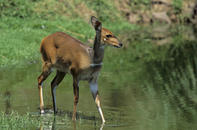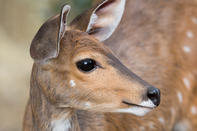Groups and Singles
Bushbuck are the smallest tragelaphines (spiral-horned antelope) in the Lowveld and in some areas are shy and secretive and in others quite common and conspicuous.

In areas where there is a good supply of food and water, their homeranges can be as small as half a hectare and as a result, bushbuck may exist at relatively high densities. They are usually solitary or in small same-sexes groups or pairs although they do sometimes aggregate in open areas abutting their usual riparian thicket habitats.
Ventriloquial Bark

They feed at night or early in the morning and late afternoon. A dominance hierarchy is maintained between members within a given area and like other tragelaphines is established through lateral display.
Although they do not defend territories, bushbuck are known to be aggressive with one another and with other threats including humans even killing them in extreme cases.
A loud deep resonating bark raises the alarm. The sound is not proportional to the size of the animal. Because they freeze when in danger and rely on their crypsis to conceal them, the bark is ventriloquial to put predators off. Bushbuck are remarkably strong swimmers. The calves have an exceptionally long lying-up period of 4 months.
By Megan Emmett